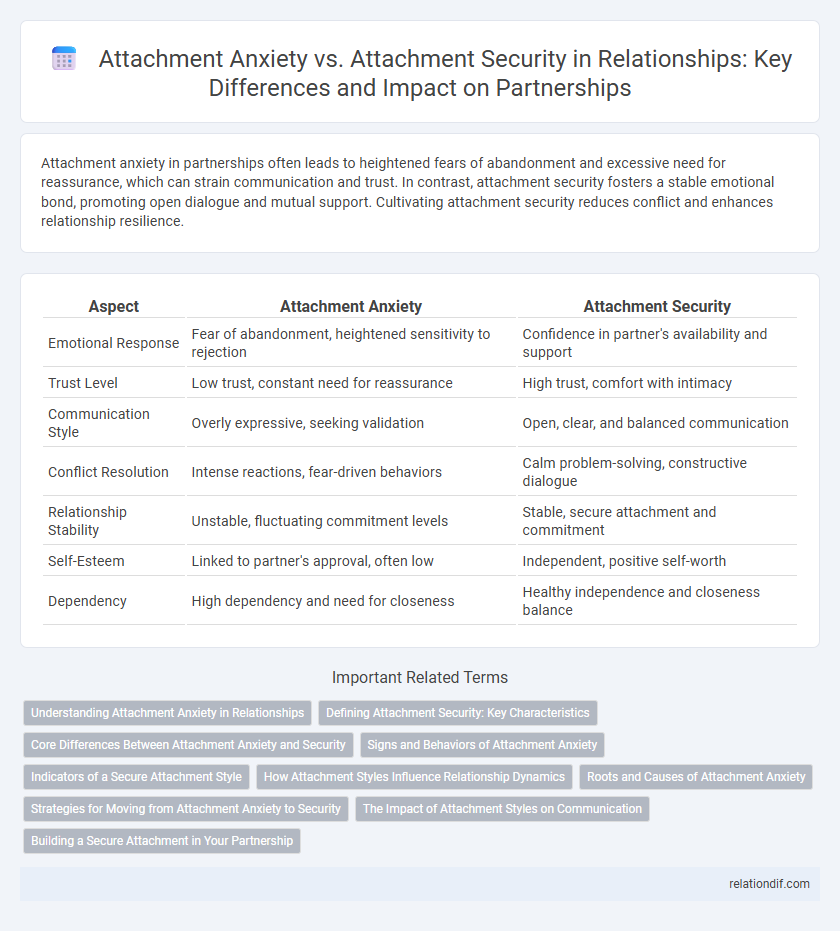Attachment anxiety in partnerships often leads to heightened fears of abandonment and excessive need for reassurance, which can strain communication and trust. In contrast, attachment security fosters a stable emotional bond, promoting open dialogue and mutual support. Cultivating attachment security reduces conflict and enhances relationship resilience.
Table of Comparison
| Aspect | Attachment Anxiety | Attachment Security |
|---|---|---|
| Emotional Response | Fear of abandonment, heightened sensitivity to rejection | Confidence in partner's availability and support |
| Trust Level | Low trust, constant need for reassurance | High trust, comfort with intimacy |
| Communication Style | Overly expressive, seeking validation | Open, clear, and balanced communication |
| Conflict Resolution | Intense reactions, fear-driven behaviors | Calm problem-solving, constructive dialogue |
| Relationship Stability | Unstable, fluctuating commitment levels | Stable, secure attachment and commitment |
| Self-Esteem | Linked to partner's approval, often low | Independent, positive self-worth |
| Dependency | High dependency and need for closeness | Healthy independence and closeness balance |
Understanding Attachment Anxiety in Relationships
Attachment anxiety in relationships often leads to heightened fears of abandonment and excessive need for reassurance, impacting emotional intimacy and trust. Individuals with attachment anxiety may exhibit clinginess or over-sensitivity to perceived rejection, which can strain communication and conflict resolution. Cultivating attachment security through consistent support and open dialogue fosters stability, promoting healthier, more resilient partnerships.
Defining Attachment Security: Key Characteristics
Attachment security is characterized by trust, effective communication, and emotional availability within a partnership. Partners with attachment security display confidence in each other's support and exhibit low levels of jealousy or fear of abandonment. This secure bond fosters resilience, allowing couples to navigate conflicts constructively and maintain long-term relational satisfaction.
Core Differences Between Attachment Anxiety and Security
Attachment anxiety involves a heightened fear of rejection and a persistent need for reassurance, leading to clinginess and emotional volatility in partnerships. In contrast, attachment security is characterized by trust, emotional openness, and comfort with intimacy, fostering stable and supportive relationships. These core differences influence how partners respond to conflict, communicate needs, and maintain emotional balance.
Signs and Behaviors of Attachment Anxiety
Attachment anxiety in partnerships is characterized by persistent fear of abandonment, heightened sensitivity to partner's actions, and excessive need for reassurance. Individuals with attachment anxiety often display clingy behaviors, emotional volatility, and struggle with trust, leading to frequent misunderstandings. These signs include constant checking for signs of rejection and difficulty regulating emotions, contrasting sharply with the stability and confidence found in attachment security.
Indicators of a Secure Attachment Style
Indicators of a secure attachment style in partnerships include consistent emotional availability, effective communication, and mutual trust. Partners with secure attachment demonstrate comfort with intimacy, balance independence with closeness, and show resilience during conflicts. This attachment style fosters healthy interdependence and long-term relationship satisfaction.
How Attachment Styles Influence Relationship Dynamics
Attachment anxiety often triggers heightened sensitivity to perceived rejection, leading to clinginess and frequent reassurance-seeking behaviors that strain communication and trust within partnerships. In contrast, attachment security fosters open emotional expression, stable trust, and effective conflict resolution, enhancing relationship satisfaction and resilience. Research indicates that secure attachment styles correlate with healthier relationship dynamics, while anxious patterns can perpetuate cycles of distress and misunderstanding.
Roots and Causes of Attachment Anxiety
Attachment anxiety stems primarily from inconsistent caregiving during early childhood, where unpredictable emotional availability from primary caregivers disrupts the development of secure attachment. This inconsistency leads to heightened sensitivity to rejection and a persistent fear of abandonment in adult partnerships. In contrast, attachment security arises from reliable, responsive caregiving, fostering trust and emotional regulation essential for healthy relationship dynamics.
Strategies for Moving from Attachment Anxiety to Security
Addressing attachment anxiety involves cultivating self-awareness and practicing mindfulness to reduce emotional reactivity in partnerships. Developing secure communication patterns, such as expressing needs clearly and validating partners' feelings, supports building trust and emotional safety. Engaging in consistent, supportive interactions reshapes attachment dynamics, fostering stability and security within the relationship.
The Impact of Attachment Styles on Communication
Attachment anxiety often leads to heightened sensitivity to perceived rejection, causing communication to become overly cautious or excessively seeking reassurance in partnerships. In contrast, attachment security promotes open, honest dialogue and effective conflict resolution, fostering trust and emotional intimacy. Understanding these attachment styles helps couples improve communication patterns by addressing underlying fears and encouraging supportive interactions.
Building a Secure Attachment in Your Partnership
Building a secure attachment in your partnership fosters trust, emotional safety, and effective communication, reducing feelings of attachment anxiety. Partners who cultivate secure attachment patterns enhance intimacy by responding consistently and empathetically to each other's needs. Developing secure bonds involves recognizing anxious behaviors, practicing reassurance, and creating a stable environment that nurtures mutual support and understanding.
Attachment Anxiety vs Attachment Security Infographic

 relationdif.com
relationdif.com